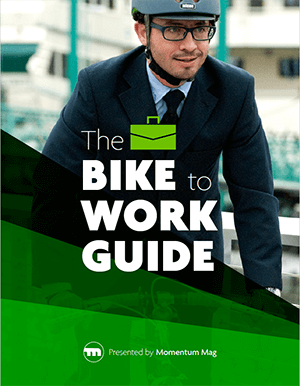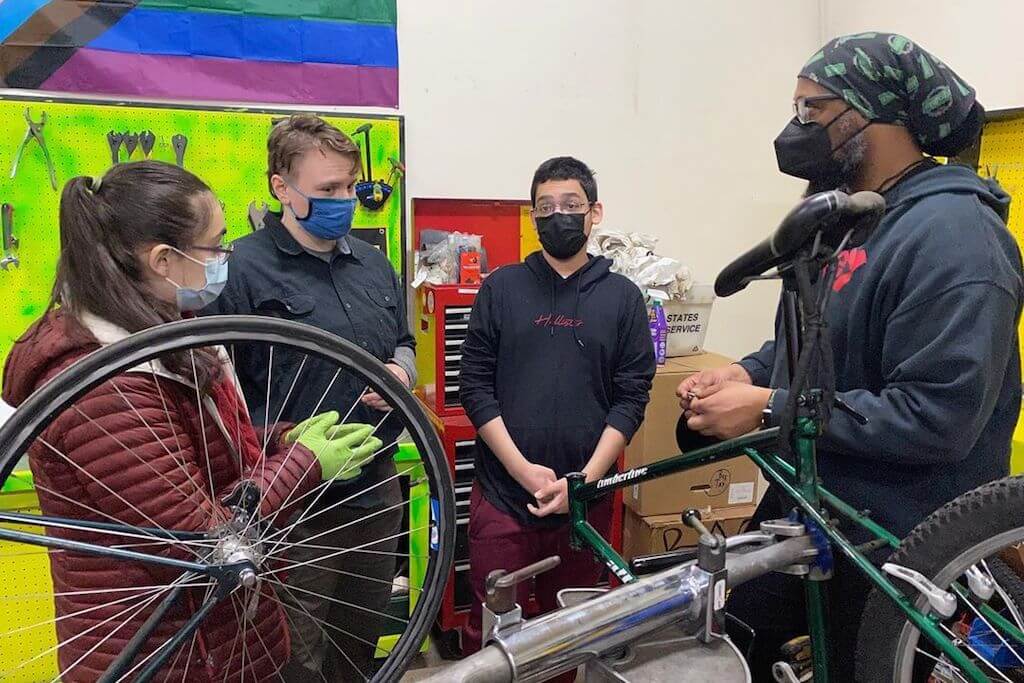
Isn’t it obvious how to safely pass a bicycle in a car? Apparently not.
Some time ago, police in the Canadian capital of Ottawa, Ontario launched an awareness-building campaign about the province’s one-metre (3.3 ft) passing law. The police, riding bikes equipped with a sensory gadget that beeped when drivers came closer than one metre, were pulling over offending motorists to inform them that their pass was too close. They weren’t handing out the $110 CAD fines that legally accompany the indiscretion, simply informing the motorists about the law and letting them know that ticketed enforcement will begin soon.
When CBC News Ottawa posted a video of the campaign to social media after the fact, the reaction was predictably, uh, mixed. While more than 2,000 of the 1.3 million viewers ‘liked’ the video and offered words of support, many of the presumed “team car” viewers were less-than-impressed or outright shocked by the endeavor.
Most of the confusion stemmed from the fact that, in order to give the cyclist one metre of space, the drivers would have to cross the solid yellow line into oncoming traffic. “Ok so seriously what should the drivers have done?” wrote Jen Jaijiwan Leech. “The cyclist driving next to the parked cars is on the white line. As the cars went around them they were on the yellow line. So would they drive into oncoming traffic? Or drive w bikes speed and every cyclist causes a major traffic jam? I don’t see how anyone could have avoided that ticket.”
Reading through the thread, you’ll find thousands of comments similar to Leech’s. Viewers wrote in with a combination of outrage, bewilderment, typical “cyclists don’t follow the rules or pay for the roads” arguments, accusations of a policing double standard, bizarre allegations that bikes are ruining the economy, even “feeling sick” and “disgusted” by the law.
So in light of all of the confusion, we thought we’d try to clear things up a bit with a handy safe passing how-to guide for motorists everywhere. Alternative title – how to not accidentally kill people with your car, for beginners!
1. Slow Down.
When you’re approaching a person riding a bike, slow down. As you’ll see in the next few steps, passing a person a bike is going to require you to make a few more moves than just continuing on your course, so reduce your speed in order to prepare yourself.
2. Leave 3 feet (one metre) of space between your car and the person biking.
This should not be the case only in jurisdictions where a safe passing law is instituted, this should just be the minimum standard. People riding bikes don’t always ride in a perfectly straight line, especially in cities where they frequently need to swerve in order to avoid potholes, storm drains, cracks, or road debris. Leaving a minimum of 3 feet (one metre) of space between you and the person riding ensures they have room to swerve if need be, even when you’re right alongside them.
3. Signal, change lanes.
Unless there’s a solid shoulder, most roads in North America are not wide enough to safely pass a person on a bike while remaining in your lane. Most motorists’ workaround for this is to simply pass them unsafely. If you can’t leave a person biking a minimum of one metre (3 feet) of space while remaining in your lane, it is your responsibility to signal and change into the other lane, or at the very least to signal and briefly move into the other lane before coming back into your lane after passing the cyclist.
In the Ottawa case, the lane the motorists would have to move into was an oncoming traffic lane, separated by a solid yellow line. This is where many of the commenters were confused – was the driver supposed to just swerve into oncoming traffic?? In fact, yes they were. In most jurisdictions with safe passing laws, the legally required move, in this case, would be to wait until it’s safe to briefly swerve into oncoming traffic in order to leave room for the cyclist, then get back in your lane as soon as you pass the person.
But what if you can’t swerve into oncoming traffic? Well….
4. Wait.
If you can’t pass the person by a safe distance because of oncoming traffic or the inability to change lanes, then you don’t pass them. It’s really that simple! Slow down and remain behind the person cycling until you can pass them safely. “But that’s absurd and sickening and disgusting,” many may think, but in reality, it’s actually not that ludicrous. Sure, you might have to drive pretty damn slowly for a bit there, but hey, it just means you’ll only be around 32 seconds later in arriving at your next red light. Was that really so bad? And on the bright side, you didn’t kill anyone! A job well done.
5. Don’t honk or yell
This last step is not so much a “how-to” as a “how-not-to.” When you’re passing a person riding a bike, even by a metre and even going slowly, it’s generally appreciated if you don’t lay on your horn and yell obscenities at them. Not least because that’s rude and discouraging, but also incredibly startling. If you startle somebody biking, it could lead them to momentarily wobble which, in traffic, could be dangerous.
If you really feel the need to yell, try “Great bike, you’re awesome!” We’ll be more than happy to accept the compliment at the next intersection 😉
Get your FREE copy of our new guide: Momentum Mag's Bike to Work Guide
Bike commuting is practical, liberating, and a great way to integrate fresh air and exercise into your daily routine. In this guide we outline the major benefits of bike commuting, go over the equipment you’ll want, provide solutions to any concerns, and offer advice on route planning and other practicalities.
Thank you for your submission. Please check your inbox to download the guide!








You couldn’t pick a worse photo to illustrate the 3-foot rule. Showing a ‘cyclist’ in the gutter pan with one foot on the curb, is likely to make some people think the 3-feet is measured from the edge of the road, not from the edge of the cyclist.
The cyclist would do themselves a great service if they also kept at least three feet between themselves and the edge of the road. That would guarantee them more room side to side to avoid potholes, debris, and sewer grates. It would also give them some room to maneuver in case some driver doesn’t give them 3-ft. as they pass.
The further to the left the cyclist rides, the further to the left a motorist must move to give them 3 ft. clearance. Eventually, it becomes obvious that the safe and logical thing to do is just make a complete lane change, just as you would for any vehicle.
How?
CHANGE LANES TO PASS!
Regardless where the Rider is riding on the road!
don’t speed around the cyclist with or without an approaching vehicle…it’s unnerving!
Why show that person on the bike ineffectively – apparently ignorantly – leaning on the curb apparently intending to go straight through the intersection? The Bike Lane stripe is dashed approaching intersections to remind and allow everyone to take their appropriate position for their intended movements – people intending to turn right are supposed to scan, signal, and merge to the right-hand portion of the lane – as close as practicable to the curb or shoulder, right? People intending to travel straight have not business hugging the curb or shoulder; very likely to be Right-hooked. When a person bicycling cannot – for whatever reason – merge to an appropriate lane or position in a lane for their intended destination, they may and should move to a pedestrian-crossing mode; move to the sidewalk or side of the highway, get off their bike, and cross as a pedestrian.
Unfortunately the picture is misleading. A cyclist should never be that close to the curb, even when stopped, and a 3-foot distance will usually require changing lanes. A cyclist should never get into the trap of thinking they need to hug the curb to allow cars to pass in the same lane.
Motorists need refresher courses. Period. Some licensed drivers don’t even know adult bicyclists are required by law to ride in the road in my city. I have never had a bike mirror that survived a week in use. I am so weary of people laying on the horn as passing, including city bus drivers. It scares the bejesus out of me. I intentionally swerve left to protest.
Is this really necessary? Wasn’t this covered in drivers education when you were a teenager; how to safely pass a slower moving vehicle? Seems like a basic skill that should be pretty refined if you’re going to drive a car, eh?
However, it isn’t a skill that most drivers can preform when it comes to passing a cyclist. I highly recommend using a mirror of some kind to be watching how things are going behind you. My preference is a helmet mount mirror because it allows me to change the view with slight movements of your head. I don’t understand why using a mirror while cycling isn’t common practice, there is absolutely no downside to it and a lot of potential upside.
@Rich: considering that I was passed unsafely while riding to work this morning, yes, this article is unfortunately necessary. I wish the police in my area would do enforcement of the minimum passing rule. I’d also like one of those sensory gadgets for my own bike : )
It’s so very necessary. Even the driver education instructors I recently taught did not fully get this. “I will not risk the life of many to save the life of one,” was what I was told when showing a truck crossing a double yellow (US) to move around a cyclist. The person felt it would be too risky and, though an unfortunate situation for the cyclist, would just have to be the risk the cyclist took when riding on “our” roads. Education of our educators is incredibly important. Use full lane to pass.
Unfortunately, many motorists don’t consider bicycles as vehicles, so how they pass a slower vehicle is not what they consider in the situation.
I am glad to see this article, but wish it had more editorial oversight. I completely agree with the need for better education of motorists and cyclists on safe behavior and coexistance on the road.
However, setting a “standard” of one meter or 3 feet between the motor vehicle and the cyclists is arguable at best. I totally agree some distance should be in every jurisdiction’s law books. One meter or 3 feet is very minimal. NO ONE riding a bike that is passed by a motor vehicle at speed, especially a bus or truck, would EVER feel comfortable with only 3 feet. Sure, at slow speeds less than 5-10 mph, 3 feet is fine. But at 25 to 45 mph, ARE YOU KIDDING?! Have you ever ridden a bike before? That is way too close. Some jurisdictions use 5 feet, or about 1-1/2 meters, a bare minimum in my book.
My challenge of the 3 foot standard should not detract from the need to educate and set some kind of standard. Many jurisdictions have no definitive passing distance standard at all. Many cycling laws simply state pass at a “safe distance” or something nebulous like that. So bringing the subject up is well warranted. Many jurisdictions do need to update their laws and it is great if law enforcement is actually enforcing the laws in a proactive manner – before the cyclist has been run over.
I apologize if I’ve misunderstood what you’re saying, but the 1m/3ft standard is not something the writer arbitrarily made up. In most jurisdictions in the United States, this is actually law.
Also, it is by no means the set distance by which a motorist should pass a cyclist, it is a MINIMUM SAFE DISTANCE. There should be AT LEAST three feet or one meter between car and bicycle. Ideally, the motorist would change lanes entirely, which would give the cyclist three meters instead of only one. In most jurisdictions where I personally ride, the law is to pass a bicycle as though you were passing any other vehicle. Signal, change lanes entirely, and do not return to the original lane until you are well clear of the passed vehicle.
Nobody is saying there should ONLY be one meter in passing, they’re saying there should be AT LEAST one meter in passing.
Percival – I agree. However when I pass a cyclist, I slow down and straddle the line but don’t completely go to the other lane. Why? Because I am afraid that the car following will NOT change lanes, which happens all to often.
Percival,
I understand what you are saying and I agree that the 3 ft or 1 meter distance is common in many jurisdictions – at least in the US. It’s not universal, however. I do appreciate Momentum bring the issue to a forefront.
My point is that 3 ft or 1 meter is simply NOT SAFE – as you stated. As others have said before me, “if that is the law, the law is an ass”. I believe the 3 ft / 1 meter distance is an old fashioned notion, that was never based on any data or testing. I’m suggesting the bicycling community should not continue to promote an idea founded on ignorance.
Anyone that rides a bike knows cyclists cannot maintain a line traveling down the road that is better than plus or minus 3ft or 1 meter. With the roads of today, we MUST constantly weave back and forth to avoid potholes, ruts, trolly tracks, glass and metal debris on the road to name a few obstacles. The law and motorists need to anticipate this reality. I stand by my statement. No one riding a bike, passed at a distance of 3 ft or 1 meter by vehicles traveling at speeds of 25 mph or greater, would ever agree it is a safe distance for passing.
I understand law makers want to keep their heads buried in the same on this issue, but I would like to encourage the media to speak up for the safety of us all.
Comments are closed.